Imparare ad allevare maiali per la carne è un'ottima opzione per qualsiasi fattoria o fattoria che voglia diventare più autosufficiente. Ma scegliere la razza e personalizzare la cura richiede un po' di know-how. Continua a leggere per 12 suggerimenti per allevare maiali per la carne.
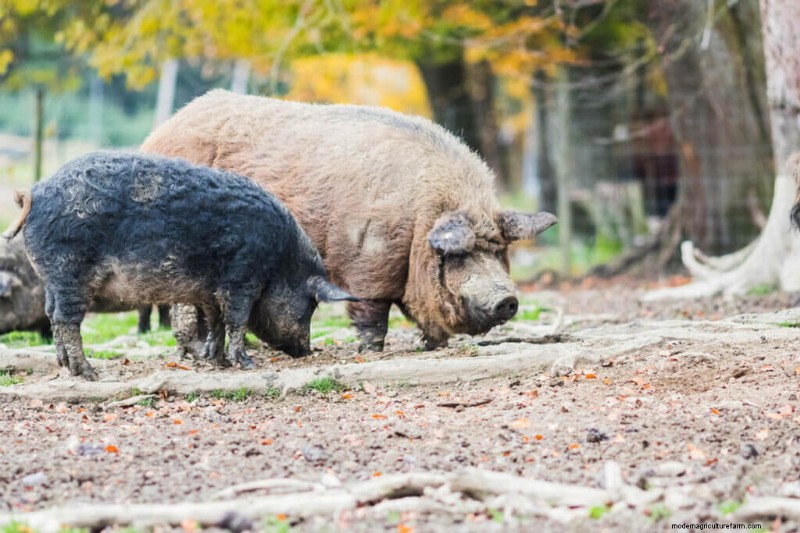
Questo post è stato originariamente scritto e pubblicato nel 2015 da Amy di Autumn Creek Ranch e da allora è stato aggiornato per includere la mia intervista con "Pork" Rhyne Cureton per ulteriori informazioni. Buon divertimento!
Nei podcast precedenti ho discusso di come ho allevato i porcellini d'India americani e perché abbiamo scelto quella razza specifica. E in un altro podcast ho discusso se pensavamo che valesse la pena allevare porcellini d'India per la carne , incluso se li rilanciamo o meno.
L'ospite del podcast di oggi (Pioneering Today Podcast episodio #331) è "Pork" Rhyne e ho avuto la fortuna di incontrarlo alla Homesteader's of America Conference . Non vedevo l'ora di farlo partecipare al podcast per discutere di tutto ciò che riguarda i maiali!
"Pork" Rhyne lavora come educatrice agricola internazionale ed esperta di marketing di carne di nicchia. Ha dedicato la sua vita alla formazione e all'istruzione di agricoltori esperti e principianti in materia di affari e marketing. (Leggi fino in fondo a questo post su dove puoi trovare Pork online!)
Se non sei a un punto in cui sei pronto ad allevare la tua carne, vale a dire il maiale poiché questo è l'argomento del giorno, voglio consigliare Butcher Box .
Butcher Box sembra essere uno sponsor del podcast Pioneering Today e hanno uno speciale in corso fino al 20 gennaio 2022 chiamato New Year's Bundle. In questo pacchetto, solo per i nuovi abbonati, riceverai 7 libbre di carne GRATIS nella tua prima scatola! Vai su butcherbox.com/pioneeringtoday per registrarti!
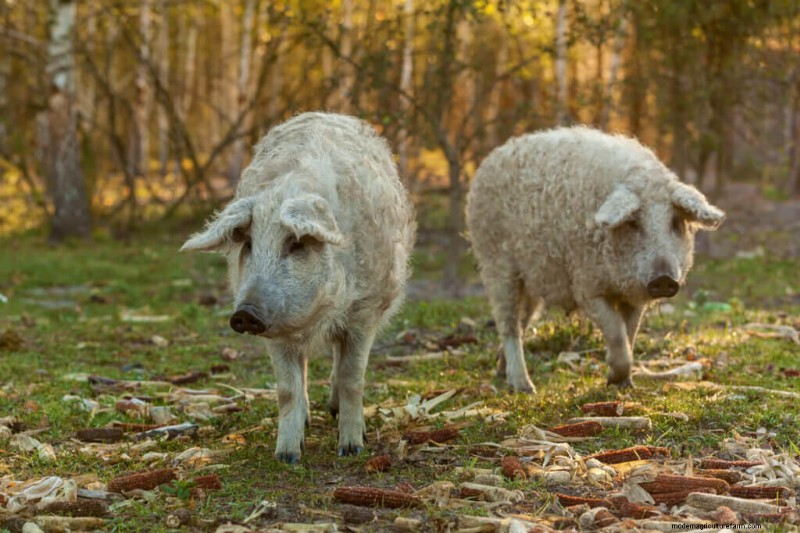
Penso davvero che i maiali siano uno degli animali più facili da allevare in una fattoria. Maturano un po' più velocemente di una mucca da carne e producono molta più carne (e strutto) di un pollo o di un coniglio (e francamente maiale stirato, pancetta fresca, lardo fatto in casa e prosciutti sotto sale sono semplicemente fantastici!!!).
Prima di dedicarti all'allevamento di maiali, per ulteriori informazioni sull'allevamento della tua carne, assicurati di dare un'occhiata a questo post sulla pianificazione del bestiame e sull'allevamento di carne a sufficienza per un anno di cibo . Oltre a quanto segue per altri post specifici sugli animali:
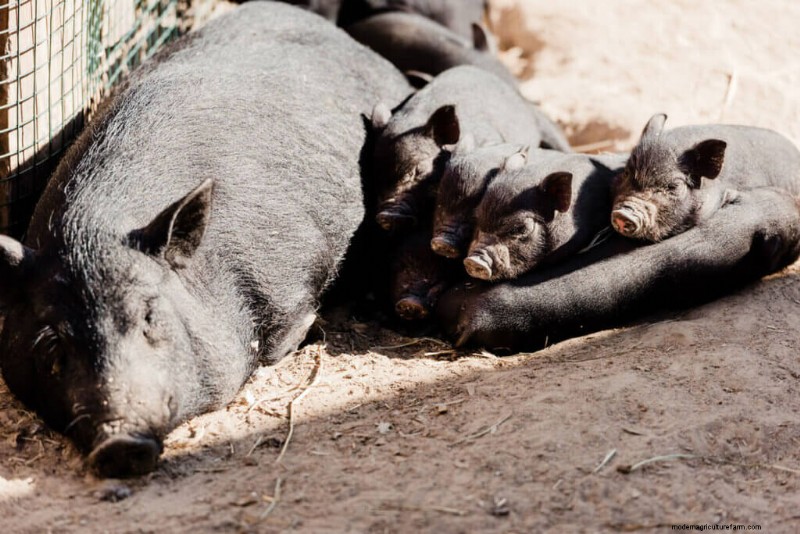
Quindi forse hai pensato di allevare un maiale (o due) e non sai da dove cominciare? Ecco alcuni suggerimenti e indicazioni che spero ti possano aiutare nel tuo modo di allevare il tuo delizioso maiale .
Per chi è interessato ad allevare solo pochi maiali all'anno per la carne, è più facile acquistare maialini che allevare il proprio allevamento.
I maialini variano di prezzo a causa della posizione, del periodo dell'anno (sono più costosi in primavera quando i bambini in 4-H stanno cercando di trovarli) e della razza.
Al momento della stesura di questo post (2015) i maialini venivano venduti a circa $ 125 l'uno, ma potevano essere trovati a partire da $ 75 a seconda della domanda del mercato. (Adesso i prezzi sono probabilmente più alti.)
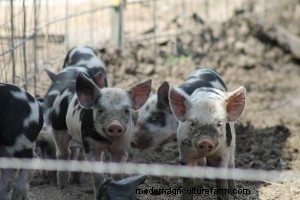
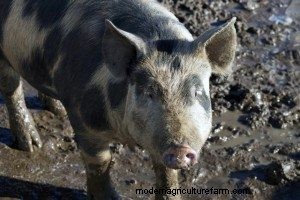
Lo standard del settore per la vendita di maialini è di 6 settimane di età. Tuttavia, vendiamo i nostri suinetti a 8 settimane di età perché scopriamo che i suinetti che possono rimanere con la scrofa per quelle due settimane in più hanno un sistema immunitario più forte e non hanno bisogno di essere alimentati con mangime iniziale.
Naturalmente, ciò significa che dobbiamo nutrire la scrofa in più per mantenere le sue condizioni, ma pensiamo che ne valga la pena avere maialini più sani.
Se riesci a trovare maialini a cui è stato permesso di allattare un po' più a lungo, vale il costo aggiuntivo in quanto ti farà risparmiare sia sulla bolletta del mangime che sui potenziali problemi di salute del maialino.
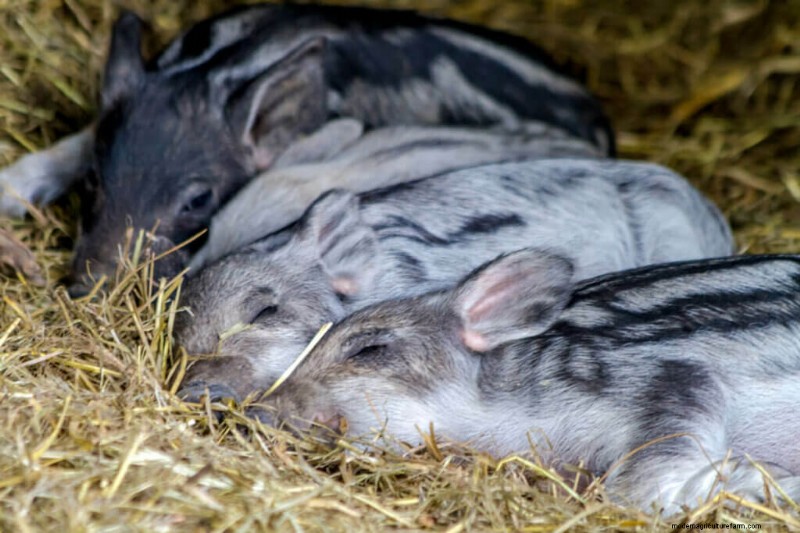
Prima di portare a casa i maialini devi avere un recinto e una specie di riparo per loro. Parlerò di più della scherma tra un minuto, ma ci sono alcune considerazioni da tenere in considerazione quando pianifichi il tuo recinto.
Se il recinto è piccolo, i maialini cresceranno più velocemente perché non avranno tanto spazio per fare esercizio e il terreno può essere davvero distrutto.
Inoltre, in un'area più piccola, i parassiti hanno maggiori possibilità di crescere. Infine, un piccolo recinto in primavera, quando il tempo è umido, può trasformarsi in un grande pozzo di fango.
Tuttavia, come Pork Rhyne discute nell'intervista del podcast, questo non significa che devi avere spazio per allevare all'aperto o pascolare i tuoi maiali. Allevare i propri maiali è un enorme passo avanti rispetto all'acquisto di prodotti a base di carne di maiale allevati commercialmente, anche se non si hanno le condizioni di vita ideali per quei maiali.
Preferiamo utilizzare aree a rotazione nei mesi più caldi e aree molto grandi più vicine alla casa nei mesi più freddi (in realtà mettiamo i maiali nelle nostre aree del giardino durante l'inverno in modo che possano dissodarle e fertilizzarle in preparazione per la semina primaverile).
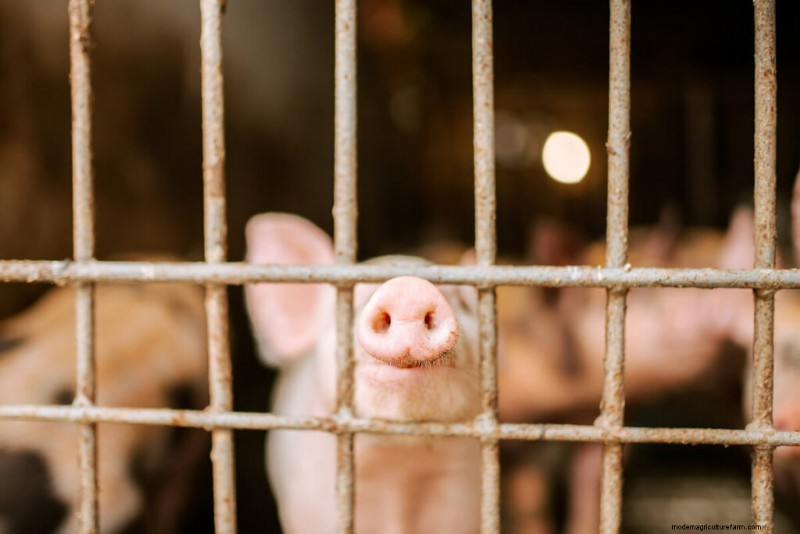
Quando i maialini sono giovani, è meglio che stiano in un pannello per bovini, in un pannello per maiali o in un recinto per pallet.
La rete elettrica, lo spago o il filo non funzionano bene con i piccoli maialini perché possono uscire (parlato da tanta esperienza e un maialino che è decollato per due settimane nei boschi circostanti di nostra proprietà).
Teniamo i maialini in un piccolo recinto per bovini con filo elettrico sul fondo fino a quando non hanno circa 12-15 settimane e poi li trasferiamo in recinti realizzati con filo o filo elettrico fino a raggiungere il peso di macellazione.
Di solito, entro 12-15 settimane sono addestrati all'elettricità e sono abbastanza grandi da non rovinare il passaggio. Tuttavia, è bene avere una via di uscita o un cancello che non sia elettrico. I maiali possono essere così ben addestrati alla scherma elettrica che quando vorremo spostarli non si avvicineranno a un luogo che UTILIZZAva per la recinzione elettrica.
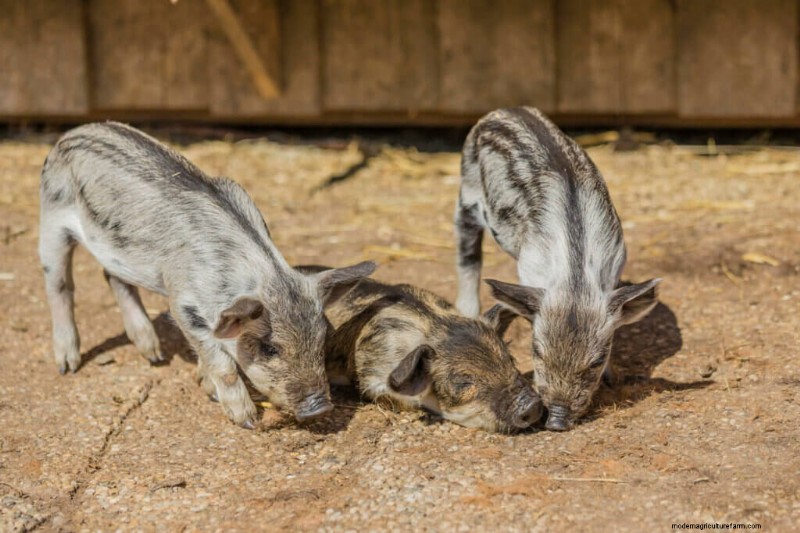
Ci sono molti modi possibili per nutrire il tuo maiale. Il più semplice è acquistare un coltivatore di maiali commerciale. I maiali crescono più velocemente con questo tipo di razione. Sfortunatamente, la maggior parte delle formule commerciali per i coltivatori di maiali contengono mais e soia, che è probabilmente OGM.
Molti mangimi commerciali contengono anche farmaci che potrebbero non essere necessari per il tuo particolare animale.
Dal momento che non ci piace somministrare farmaci inutilmente ai nostri animali, un'altra opzione è quella di preparare il tuo mangime da una fonte di cereali e proteine o trovare un mangime naturale già pronto nella tua zona.
Ecco cosa ha da dire Pork Rhyne sull'alimentazione dei maiali... Ci sono così tante polemiche su cosa dare da mangiare ai maiali, tutto, dall'andare al panificio locale e nutrire i maiali con il pane vecchio di un giorno, fino all'acquisto solo del miglior mangime biologico e non OGM.
Ci sono così tante persone che stanno appena iniziando ad allevare maiali che in realtà non sanno che aspetto abbia un maiale sano. Quindi consiglia di trascorrere del tempo con qualcun altro che alleva maiali per imparare e abituarsi a quanto dovrebbero mangiare i maiali, a come i loro appetiti variano in base alle stagioni e all'aspetto di un maiale sano.
Noi proprietari di case amiamo il percorso alternativo, ogni volta che possiamo fare il fai-da-te o avere un modo alternativo di fare qualcosa, ci salteremo sopra! Penso che sia nella nostra natura. Ma prima di immergerti nella preparazione del tuo mangime per maiali, è importante comprendere i componenti del mangime per sapere come nutrire un maiale al fine di ottenere un prodotto con un rapporto grasso:carne di cui sei soddisfatto quando arriva il momento di macellare.
Una volta che hai i componenti di base del mangime, è anche importante conoscere la tua razza specifica perché ogni razza avrà esigenze diverse di carboidrati e proteine.
Quando si tratta di porcellini d'India americani, sono inclini all'obesità, quindi hanno bisogno di una dieta a basso contenuto di carboidrati per evitare di ingrassare troppo.
Pork Rhyne aveva un amico che era davvero deluso dalla quantità di carne in rapporto al grasso che aveva ottenuto dopo aver macellato i suoi maiali, ma si scopre che dava ai suoi maiali il 16% di proteine grezze per tutta la loro vita invece di ridurre le proteine prima della macellazione .
In genere, circa 2-3 mesi prima della macellazione, Pork Rhyne consiglia di ridurre la quantità di proteine fino al 12-14% e di aumentare la quantità di carboidrati per trasformare quell'energia in grasso.
Come ho detto sopra, tutto questo varia tra le razze ed è diverso per hereford, razze ereditarie, razze commerciali, ecc.
Oltre al mangime preconfezionato, i maiali adorano tutti i tipi di prodotti. Puoi persino coltivare colture specifiche per i tuoi maiali come mangels, rape da foraggio, barbabietole e zucca.
Nella nostra fattoria, nutriamo una combinazione di orzo e piselli di provenienza locale con l'aggiunta di minerali suini. I nostri maiali ricevono anche tanto latte fresco, avanzi della tavola, mele e zucche nostrane.
Per favore, non dare da mangiare ai tuoi maiali avanzi di panetteria e simili e aspettati un maiale sano con carne dal sapore eccezionale. Mangi quello che mangia il tuo maiale, quindi la qualità è importante.
Un altro esempio di modi per nutrire i maiali è che Pork Rhyne ha un amico che è andato a Chipotle (la catena di fast food) e ha raccolto fagioli che non erano stati venduti ai consumatori per nutrire i suoi maiali.
Sono tutto per essere intraprendente! Assicurati solo che il cibo che stai ricevendo non sia post-consumo (il che significa che non è stato servito prima a un cliente, poi gettato nella spazzatura perché diffonderebbe malattie ai tuoi maiali) e assicurati che non ci sia carne di maiale nel prodotto.
Una cosa che amo fare è procurarmi il mio feed il più localmente possibile. Abbiamo un granaio a circa un'ora di distanza che ha una posizione non OGM e cerca anche di procurarsi il grano il più localmente possibile. Per consigli su come risparmiare sugli acquisti dal tuo granaio locale, dai un'occhiata a Fare scorta di mangime per animali (+ Quanto nutrire gli animali).
Sappi anche che se dai da mangiare ai tuoi maiali grano esaurito (come il grano dei birrai che potresti ottenere da un birrificio), circa l'80% è acqua. Ad esempio, se quel grano fosse secco, conterrebbe circa il 29% di proteine, mentre una volta che il grano è bagnato (o esaurito), contiene solo il 7,7% di proteine grezze.
Anche il grano esaurito si ammuffisce molto rapidamente, quindi Pork Rhyne lo consiglia come aggiunta a una dieta, non come fonte primaria.
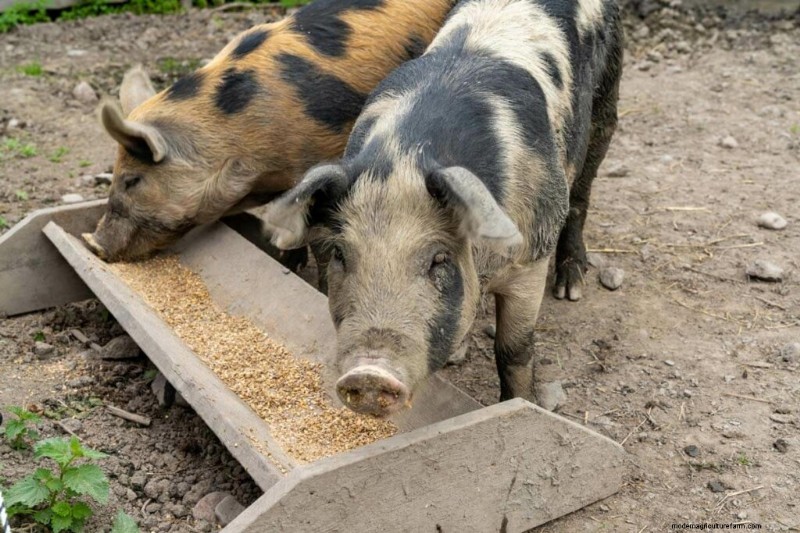
Un'altra cosa da considerare quando si allevano i maiali è se allestire un alimentatore automatico e lasciare che i maiali mangino quando vogliono o dar loro da mangiare una quantità prestabilita ogni giorno.
Ci sono pro e contro per entrambi. L'alimentazione a domanda riduce il carico di lavoro giornaliero, tranne il giorno in cui è necessario riempire la mangiatoia per maiali. Inoltre, se i maiali hanno sempre cibo a disposizione, sarà meno probabile che radichino così tanto e quindi il tuo terreno rimarrà in condizioni migliori. Anche i maiali alimentati a domanda tendono a crescere più velocemente, quindi il tempo per raggiungere la maturità è inferiore.
Il problema con l'alimentazione su richiesta è che i maiali possono mangiare MOLTO cibo e questo può diventare costoso, soprattutto quando i maiali invecchiano.
Abbiamo scoperto che se stai allevando solo uno o due maiali, l'alimentazione a richiesta è la strada da percorrere. Quando stai rilanciando di 10 o più è quando può diventare un costo proibitivo.
Diamo a ciascuno dei nostri maialini 5 libbre della loro miscela di cereali ogni giorno. Oltre a questo, ottengono latte, avanzi di tavola e prodotti agricoli.
Questo ci permette di avere suini di peso commerciale di circa 8 mesi circa.
Non sono un fan dei vermifughi chimici a causa delle mutazioni e delle resistenze che creano.
Nella nostra fattoria, abbiamo riscontrato che l'aglio è comunque un vermifugo molto più efficace.
Aggiungiamo circa 1 libbra di granuli di aglio a una tonnellata di mangime.
Inoltre, l'olio di origano è anche eccellente per combattere parassiti e infezioni.
Infine, teniamo a portata di mano l'olio essenziale di geranio per le emorragie (i maiali possono litigare) e l'olio dell'albero del tè per tagli e graffi.
La castrazione dei maiali è una questione controversa. Ci sono molti che trovano la pratica crudele e inutile, ma altri dicono che deve essere fatto per prevenire l'odore di cinghiale.
Se stai allevando due maiali maschi, dovrai determinare se vuoi eseguire questa procedura.
Tuttavia, quando allevi maialini del sesso opposto, è saggio andare avanti e castrare. Quando abbiamo iniziato ad allevare maialini ci è stato detto che non avrebbero iniziato a riprodursi prima dei 9 mesi. Dal momento che macelliamo a 8 mesi non pensavamo di dover castrare.
Cattivi consigli e siamo finiti con maiali del mercato gravidi. Ora castriamo tutti i maialini maschi allevati per la carne. Abbiamo trovato Bach's Rescue Remedy molto utile nel processo:mantiene calmi sia i maiali che la persona che esegue la castrazione.
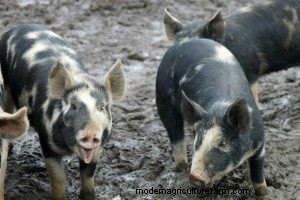
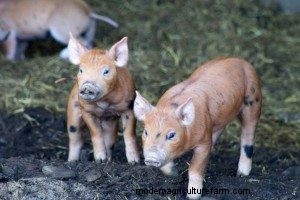
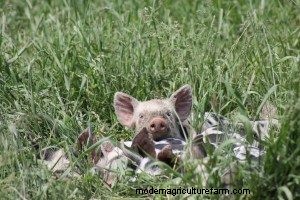
Diverse razze di maiali hanno qualità diverse, comprese differenze di dimensioni, qualità della carne e temperamento.
Queste sono cose che vorresti indagare quando scegli i tuoi maialini prima di portarli a casa.
Alleviamo razze di maiali storici (Gloucester Old Spot, American Guinea Hog, Tamworth) per il loro temperamento docile e amichevole e per l'eccellente qualità della carne.
Il porcellino d'India americano è una razza di maiale molto più piccola e non produrrà un peso della carcassa convenzionale, ma a causa della loro facile maneggevolezza e della carne di qualità da chef, è un compromesso che siamo disposti a fare.
I primi maiali di Pork Rhyne erano in realtà una razza ereditaria chiamata "large blacks" e "red wobble", ha anche allevato alcuni incroci e maiali commerciali.
200 anni fa i maiali non venivano nutriti con le diete che ricevono ora. Erano animali a basso input, proprio come i polli, dove venivano nutriti con gli avanzi della cucina o del giardino, ruminavano all'aperto, ecc.
Per molti anni, i maiali sono stati il "fail-safe". Se un raccolto ha avuto un cattivo raccolto un anno, le famiglie avrebbero sempre maiali da vendere per sbarcare il lunario.
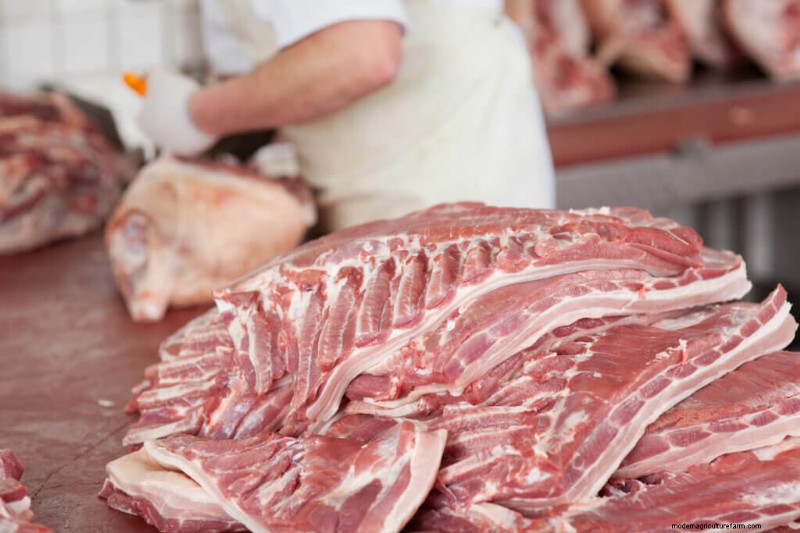
La maggior parte dei maiali storici viene macellata quando pesano circa 180-250 libbre vivi. Ciò si tradurrà in un peso sospeso (carne e ossa meno la testa, i piedi e gli organi) compreso tra 160 e 225 libbre.
La quantità di carne che finisci nel tuo congelatore dipende totalmente dai tipi di tagli che scegli durante la lavorazione.
È importante capire che i maiali di razza tradizionale crescono più lentamente dei maiali commerciali.
Di solito le razze storiche impiegano circa 8 mesi per raggiungere circa 280 libbre. I maiali da lardo impiegano fino a un anno o un anno e mezzo per raggiungere il peso alla macellazione (che a volte, a seconda della razza, non sarà così pesante).
Ma i maiali commerciali raggiungono i 280-300 libbre in soli 6 mesi. Quindi puoi capire perché i maiali commerciali sono diventati più popolari nelle grandi fattorie.
Per informazioni più precise su ogni singola razza, scarica questa tabella dalla Livestock Conservancy Organization .
Sapere per cosa vuoi allevare carne di maiale prima di scegliere la tua razza. Molte razze sono molto migliori per cose come bratwurst, salsicce, salumi, ecc., mentre altre razze ti daranno i tuoi prosciutti, braciole di maiale e grandi arrosti.
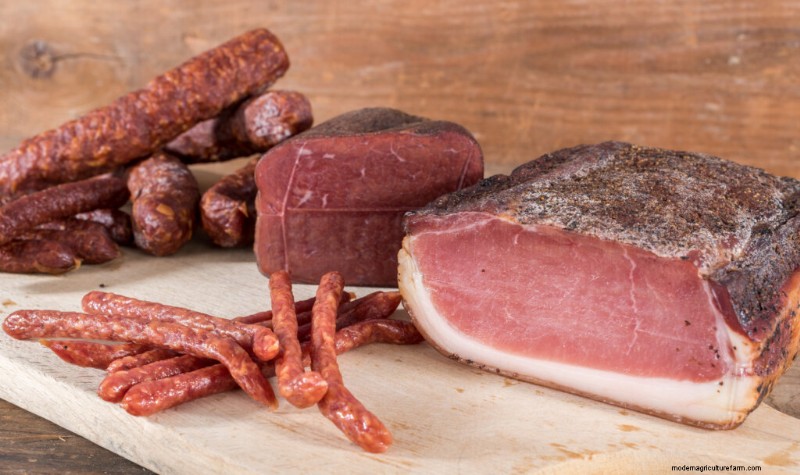
Abbiamo macellato molti maiali nella nostra fattoria. Una volta che impari a farlo non è così difficile, ma la prima volta può essere un po' intimidatorio.
L'intero processo richiede circa 3 giorni. Il primo giorno è l'uccisione e l'impiccagione, il secondo è la scuoiatura e il taglio dei pezzi, il terzo è solitamente la lavorazione della salsiccia.
Uno svantaggio di macellarti è che a meno che tu non sappia come curare pancetta e prosciutto non ti ritroverai con quei tagli (avrai prosciutto fresco che è davvero buono ma non come il prosciutto crudo tradizionale).
I vantaggi di macellare te stesso sono il know-how e il risparmio sui costi. Tradizionalmente, far macellare un maiale costa da $ 150 a $ 250 a seconda della lavorazione e della stagionatura.
Allevando i tuoi maiali controlli ciò che mangiano, il che rende un prodotto più sano per la tua famiglia.
Inoltre, allevare maiali è molto divertente e mi piace guardare le loro buffonate. Tuttavia, trovo che il motivo migliore per allevare carne di maiale sia il gusto. Una volta provato, non vorrai mai più il maiale del supermercato.

Amy è moglie e madre di 18 figli. Oltre a essere genitori e istruire a casa la loro mega famiglia, gestiscono anche una piccola fattoria familiare, che chiamano affettuosamente "Autumn Creek Ranch .” Amano il lavoro di Joel Salatin (anche io!) e hanno modellato gran parte di ciò che fanno con il suo esempio.
Hai una domanda sull'allevamento di maiali? Puoi inviare un'e-mail ad Amy all'indirizzo [email protected]
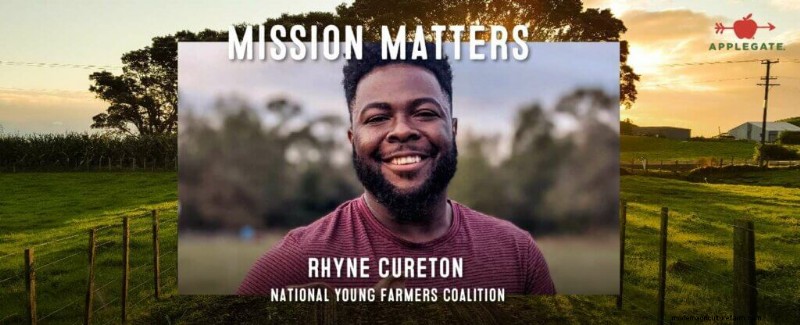
Assicurati di ascoltare il podcast (a partire dal minuto 41) per conoscere il lavoro di Pork Rhyne nei paesi del terzo mondo attraverso la società EATBETA – Evangelizing Africa Through Business Empowerement in a Transformation of Agriculture.
Melissa K Norris: Ehi, pionieri. Benvenuti all'episodio numero 331 del podcast Pioneering Today... Oggi parleremo di uno dei miei argomenti preferiti. Sento che sono tutti i miei preferiti, ma questo è decisamente in alto, e questo riguarda l'allevamento di maiali. Abbiamo già parlato dell'allevamento di maiali in diversi episodi del podcast. Abbiamo parlato della razza Heritage American Guinea Hog conosciuta... sto usando le virgolette, anche se non si vedono... un po' come, AKA, "il maiale del proprietario di casa". La mia esperienza, nelle note dello spettacolo, ci collegheremo a quelli se vuoi dare un'occhiata ad alcuni di quegli episodi precedenti, la mia esperienza con loro.
Nell'episodio di oggi, sono davvero entusiasta, perché ci tufferemo nei maiali, ma parleremo di molti consigli comuni o visti spesso quando si tratta di allevare maiali, in particolare sul mangime, cosa dai da mangiare ai tuoi maiali, gestione del pascolo e altre cose del genere che sono spesso imprecise o che non servono necessariamente al meglio il maiale e l'allevatore. L'episodio di oggi, ci tufferemo con l'ospite di oggi. Sono davvero eccitato. Sentirai, non appena inizieremo l'intervista, come li ho conosciuti, un po' di retroscena. Ti avverto che, quando lo presenterò, non alzare troppo il volume. È solo per il primo piccolo minuto. Capirai perché lo dico quando sarai lì. È tutto molto divertente e penso che ti piacerà molto sia per il suo entusiasmo che per l'argomento.
Prima che arrivi, l'episodio di oggi è sponsorizzato da ButcherBox, il che è abbastanza appropriato, dato che stiamo parlando di carne. Se non sei ancora a un punto del tuo viaggio in fattoria, o non hai un allevatore locale da cui puoi acquistare la tua carne, ButcherBox rende facile ottenere carne di alta qualità e allevata umanamente di cui ti puoi fidare. Forniscono manzo al 100% nutrito con erba e finito con erba, pollo biologico ruspante e maiale di razza tradizionale, insieme a frutti di mare pescati, direttamente a casa tua. In realtà abbiamo provato tutto quanto sopra. È sempre arrivato ed è stato completamente congelato, anche quando era alla fine della giornata, e proprio alla fine del percorso rurale che stiamo percorrendo per un fattorino. Non abbiamo avuto nessuno che non ci sia piaciuto. Sono rimasto molto colpito dalla qualità, dal sapore, dal modo in cui cucina. Tutto al di sopra di quanto sopra, se non è qualcosa che sei in grado di elevare da solo.
Una delle grandi cose è che, poiché sei un ascoltatore di Pioneering Today Podcast, c'è uno speciale in corso fino al 20 gennaio. È il pacchetto di Capodanno. Puoi ottenere sette sterline di meet gratis nella tua primissima confezione quando ti registri come nuovo cliente con ButcherBox. Per capirlo, vai su ButcherBox.com/PioneeringToday. Questo è ButcherBox.com/PioneeringToday. Ottieni i tuoi sette chili di carne gratis nella tua prima scatola. Grazie mille, ButcherBox, per essere uno sponsor del podcast Pioneering Today.
Se sei un nuovo ascoltatore del podcast, benvenuto. Un ascoltatore di lunga data, batti il cinque. Bentornato, amico mio. Mi chiamo Melissa K Norris. Sono una proprietaria di quinta generazione e aiuto migliaia di persone, ogni singolo mese, a imparare come vivere una vita fatta in casa e fatta a mano usando una fattoria semplice e moderna, non importa dove ti trovi. L'ospite di oggi è noto come Pork Rhyne. Il suo vero nome è in realtà Rhyne Cureton. Credo che sia così che dici. È conosciuto come un evangelista del maiale in tutto il paese, e anche all'estero nell'Africa orientale, di cui parleremo alcuni. Lo trovo molto interessante e affascinante. Lavora come educatore agricolo internazionale ed esperto di marketing di carne di nicchia. Per oltre cinque anni, Rhyne ha dedicato la sua vita alla formazione e all'istruzione di agricoltori esperti e principianti, principalmente sulla produzione di bestiame su piccola scala, sul commercio e sul marketing. Parleremo sicuramente di allevare carne di maiale in un ambiente di fattoria più piccolo, quindi sono davvero, davvero entusiasta di dargli il benvenuto nel podcast e di parlarne.
Per ottenere collegamenti ad alcuni degli episodi precedenti di cui ho parlato e ad alcune delle cose di cui parleremo, puoi prendere tutto questo su MelissaKNorris.com/331. Questo è solo il numero 331, perché questo è l'episodio 331. Di nuovo, MelissaKNorris.com/331. Veniamo alla puntata di oggi.
Bene, sono super eccitato per questo episodio. Vi avverto tutti. Sarà un'energia elevata, perché incontro pochissime persone che tendono ad avere il livello di energia che ho io. Senza ulteriori indugi, Pork Rhyne, benvenuto al podcast Pioneering Today.
"Maiale" Rhyne Cureton: Sono emozionato. Sono emozionato. Hai portato qui la persona sbagliata.
Melissa K Norris: Non penso al male. Sto pensando giusto. Ho adorato la tua energia alla HOA, quindi sono stato davvero contento. Stavamo chiacchierando un po' prima di iniziare a registrare, ragazzi, e praticamente gli ho inviato un invito al podcast che non gli ha dato alcuna possibilità di ritirarsi o di dire di no. Fondamentalmente ho detto:"Ehi, qual è la data e l'ora in cui vuoi uscire?" Sono davvero contento che abbia accettato il mio invito forte e armato. Sono davvero eccitato. Ho la sensazione che ne parleremo molto in questo episodio, quindi ci tufferemo subito.
Una delle cose, quando stavamo chiacchierando, era davvero [00:06:06 impercettibile]. Hai detto che vedi molte cose offerte online. Presumo, perché mi piace dare per scontato il meglio di tutti, che molte di queste cose sono offerte con buone intenzioni, ma vedi molte cose quando si tratta di allevare maiali online, o spesso, dovrei dire , che causa problemi o può essere problematico. Mi piacerebbe che tu ti immergessi un po' di più in questo argomento.
"Maiale" Rhyne Cureton: O si. O si. Entriamo in questo. Sfondo su di me. Ero solito coltivare. Tornerò in agricoltura. Ha lavorato con il National Pork Board in Pork Checkoff. Ho allevato razze ereditarie quando coltivavo. Tornerà nelle razze del patrimonio. Ho insegnato alla gente come allevare maiali, sia in tutto il paese che all'estero, negli ultimi cinque anni. Sto usando quell'esperienza per parlarne.
Una delle cose che ho notato con le persone che stanno entrando nell'allevamento di maiali e non hanno mai allevato maiali prima in tutta la loro vita, molto probabilmente non provengono nemmeno da un ambiente agricolo, è che ci sono molti problemi problemi in termini di mangimi, in termini di pratiche di terra, in termini di benessere degli animali, e oserei dire legalismo, quando entriamo in gruppi di fattoria, gruppi che sono alternativi agli standard e ai modelli convenzionali con l'industria della carne di maiale. Ho visto molta disinformazione in termini di quanto dovresti nutrire il tuo maiale.
Oddio. Melissa, ci sono così tante informazioni contrastanti. Dovrebbe far impazzire, onestamente. Sento per le persone che stanno iniziando ad allevare maiali e non hanno idea da dove cominciare, o vanno a un post sul blog e poi vanno a un paio di video di YouTube. Stanno ricevendo informazioni completamente diverse. Non c'è davvero alcuna coerenza o continuità. La maggior parte delle persone cerca una formula, come "Qual è una formula che posso usare e con cui avere successo?" L'unico mito che voglio sfatare, uno dei più grandi miti che abbia mai visto, è che non esiste una formula per questo.
Melissa K Norris: Amen. Amen.
"Maiale" Rhyne Cureton: Non esiste assolutamente alcuna formula. Ora, quando entri nell'agricoltura convenzionale commerciale, in realtà esiste una formula. Se lo segui, andrai benissimo. Per le razze tradizionali, per le persone che allevano maiali all'aperto, o al pascolo, o nelle stalle, è molto diverso. Non c'è quella coerenza perché, A, hai gli elementi che influenzano quanto mangerà un maiale. Ad esempio, quando fa più caldo, ai maiali non piace mangiare quando sono caldi. Semplicemente no. Non lo fanno per niente. Quindi la loro capacità di aumentare la massa muscolare e il grasso diminuisce perché non mangiano così tanto. Destra? Quando fa freddo, mangiano molto di più, perché stanno cercando di usare il grano, o qualunque cosa gli dai da mangiare, come un modo per generare calore per stare al caldo. Non c'è davvero alcuna coerenza perché non alleviamo maiali in ambienti di topi da laboratorio. Non lo siamo.
Una cosa che promuovo davvero è avere l'occhio di un contadino. Ciò che intendo con questo non è solo nutrire un animale, dargli acqua e riparo. Non solo quelle cose, ma tutti i contenuti intermedi. Destra? Ciò che richiede davvero sono le capacità di osservazione. Farai degli errori. Beh, non tu, Melissa, ma il pubblico. [dialogo 00:09:44]
Melissa K Norris: Oh no. Faccio molti errori, ma grazie per questo.
"Maiale" Rhyne Cureton: Cercando di non buttarti sotto l'autobus... Se stai allevando e stai iniziando, farai molti errori, in termini di alimentazione, in termini di stabulazione, in termini di benessere degli animali, e va bene. Ci sono molte informazioni contrastanti là fuori, e molte persone che stanno realizzando video o blog che non hanno, necessariamente, il background che ho io, o il background che avrebbe un allevatore di maiali convenzionale. Molte persone stanno imparando da persone che stanno appena iniziando. Ci sono molte persone che stanno imparando come allevare maiali da persone che allevano maiali da un anno o meno. Destra? Le persone che allevano maiali, e anche all'aperto, da diversi anni, cinque anni, 10 anni, 20 anni, non sono online, perché sono troppo impegnate a fare soldi allevando maiali. Questo può essere problematico in molti casi.
Una cosa che voglio dire è avere grazia con te stesso mentre inizi e capisci le cose. Basta capire che non esiste una formula e che quella formula cambia con la razza, con il particolare tipo di maiali che ottieni. Anche all'interno di una razza ci sono diverse variazioni di taglia. Melissa, tu allevi porcellini d'India americani. C'è un grande [00:11:01 impercettibile] in sella, e ce ne sono alcuni che sono stati resi davvero piccoli. La differenza nella crescita può essere molto drastica tra questi due diversi tipi all'interno di quella razza. Ci sono molte sfumature con i maiali da riproduzione.
Una parte di me ora che alla fine avvia Pork Rhyne TV è riuscire a far capire alle persone che puoi avere successo nell'allevare maiali nel tuo particolare contesto. L'importante è essere flessibili, essere in grado di accettare critiche costruttive ed essere in grado di avere capacità di osservazione e utilizzare quelle capacità di osservazione con pratiche migliori. Ho visto molte persone che purtroppo finiscono per cadere nel legalismo. Stanno dicendo:"Bene, questa persona alleva maiali in questo modo, quindi se non allevi maiali in questo modo, allora non sei un buon agricoltore". Lo sento molto. Sento un sacco di gente, tipo, "Beh, se non stai allevando i maiali al pascolo, allora non sei un buon agricoltore". Beh, credo che quasi tutti possano allevare maiali, e credo che potrei ricevere lettere di odio per questo. Non credo che la produzione di pascoli per i maiali sia l'unica via. Giusto?
Melissa K Norris: Esatto.
"Maiale" Rhyne Cureton: Sono stato in Africa. Hanno praterie. Hanno savane. Non hanno pascolo. Se hanno pascolo, non ci metteranno maiali. Stanno mettendo le mucche. Ci mettono le capre e ci mettono le pecore. I maiali sono l'ultima cosa che metteranno al pascolo. Non ha assolutamente senso. Inoltre, hanno predatori a due zampe. Destra? Non solo hanno gli animali selvatici a quattro zampe. Hanno predatori a due zampe, AKA umani, che in realtà vengono e rubano i loro maiali. Non ci sono reti elettriche quando ci sono interruzioni elettriche ogni giorno o un paio di volte al giorno. Destra? Mi piace guardare, qual è il contesto? Quali sono le tue risorse limitate? Cosa hai? Qual è la tua esperienza? Quanto tempo hai per farlo?
Quindi, quando lavoro con gli allevatori, li aiuto semplicemente a creare il proprio piano entro i limiti dati, la gestione del tempo data, il loro stile di vita dato e il modo che consente comunque il benessere degli animali. Ci sono alcune persone molto legaliste, all'interno del nostro particolare settore della fattoria e dell'agricoltura, che finiscono per colpire davvero le fattorie commerciali. Quindi il problema che vedo è quando vado in queste fattorie. I see animals in more deplorable situations than when I see when I go into a commercial hog situation, or even when I see when I go to East Africa. Explain that to me. How can one person be bashing and sense some, yet not have proper animal welfare? That makes absolutely no sense, but this is something that I see a lot in common with people who want to have a formula for how they be successful, or want to be in legalism on there's only one way of doing something right. I truly don't believe that. I think there are multiple ways of having healthy hogs, and even a healthy family with those hogs.
Melissa K Norris: Yeah. I completely agree with you on so many things, especially with the context in looking with where you at and working within the resources, and also understanding climate, as well as workload. Until very recently, actually, I worked a day job where I was commuting. I was a pharmacy tech and was commuting 18 miles one way. My husband still works off of our homestead and farm, so he still has a day job. For us, we do have our pigs on pasture, but we don't rotate them. They're not on fresh grass every day, simply because when you leave at 5:00 AM in the morning, and it's dark, and you're not getting home until sometimes 6:00 at night, if not later, there's only so many hours in the day. I think, just like you said, that that legalistic part ... Yes, no matter what method you choose to raise your pigs, you're going to want to make sure that you are raising them as ethically and as humanely as possible, but there's more than one way to do that.
I'm really happy that you're talking about that, and also looking at your climate, because, from our experience, the American Guinea Hogs that we had, it overall was a very pleasant experience that I have. Were They Worth It?: a different episode you guys can all go and listen to on that in drawing the difference between raising the Hereford versus the American Guinea Hogs. You really need to dig into your climate with the different breeds, as well as expectations.
I wanted to circle back to one of the things, and that is feed. Feed, not only how much, as you said, and definitely your climate, and the time of year, and so many things we're going to determine. The best thing is looking at the animal. Does it look healthy? Does it look underweight? Is it looking too fat, and [inaudible 00:15:45] ... but types of feed, because, as you know, that is also controversial. Who knew homesteading could be so controversial? I swear, every aspect of homesteading I talk about, there's controversy somewhere or another. I'd love to address that, because I know this is a thing where some people are like, "Well, just go. Go to the bakery and get day old bread that they're getting rid of." Then you've got your purists. Right? There's all these things. Let's talk about them. Why is that a good idea? Why is that not a good idea? All the things. Let's dive into feeding pigs.
"Pork" Rhyne Cureton: Oh, man. You mentioned earlier of what does a healthy a pig look like? I think part of the issue is a lot of people who are starting raising pigs doesn't know what a healthy pig looks like.
Melissa K Norris: Yeah.
"Pork" Rhyne Cureton: Or how a healthy pig behaves, so that's part of the reason why I'd say, before you get your pigs, spend some time volunteering on a local farm that has the practices that you want to have, if possible. That's not for everybody. Not everyone has the time or energy. Even if it's just like, "You know what? I'm just going to spend a weekend once a month going to a farm. They might be a couple of miles away, several miles away, but I want to learn how they're doing things and get acclimated," because when you're starting out with no understanding of a strong foundation of what a good animal looks like, of what good proper feed management looks like, then you're just shooting in the dark hoping that you hit something. Sometimes that might be at the detriment of your hogs. I've heard plenty of stories. Pigs die. Let me tell you something. It's hard to kill pigs. You have to really try hard to kill pigs, but I've heard plenty of stories of homesteaders that had mismanaged their pigs so poorly that they end up passing away.
Melissa K Norris: Wow.
"Pork" Rhyne Cureton: That's extraordinarily unfortunate. That's why I say get under somebody who knows what they're talking about, not just these people on YouTube or on the blog posts, but someone who's got five years of experience, even three years of experience raising pigs, and can give you a little bit of advice and guidance. If we're starting to talk about feed, one thing, at the HOA conference, I did a whole thing about alternative feed, because I know that's what homesteaders love to talk about. They love to talk about how they're getting alternative this and alternative that, and saving money here and there. Oftentimes I've seen pigs who are emaciated, or pigs who are obese, pigs who have carcass qualities that aren't what the homesteader intended them to have. Giusto?
Melissa K Norris: Mm-hmm (affirmative).
"Pork" Rhyne Cureton: If you're expecting the meaty hog but you're feeding it nothing but carbohydrates, when it's time to process it, all you're getting is a really fat, obese pig. You're getting more lard than you probably know what to do with. Now, with homesteaders it's not as much of a problem, because a lot of homesteaders like to use lard.
Melissa K Norris: Amen.
"Pork" Rhyne Cureton: Amen. Thank the lard. Praise the lard.
Melissa K Norris: Sì. Yep.
"Pork" Rhyne Cureton: Praise the lard. Praise the lard. Hallelujah ... A lot of times it's like, "Oh, but I wanted more weeks. Oh, but my bacon, it's 90% fat and 2% actual muscle meat. Why is that?" I think the biggest thing is understanding what is feed? What are the components of feed? At the conference, I talked about how very simply, and I teach this in East Africa where I'm not speaking their language. I have to have a translator to do that, so I have to speak very simply. What I normally will say is feed is made out of carbohydrates. Examples of carbohydrates using feed, would be things like corn. Right? Energy source. Right? Think of carbs as energy sources. Then you have your protein source. Oftentimes a conventional feed will use soybeans as a protein source. Right? Then you're thinking about fiber, minerals, other different aspects about feed that really go a long way in terms of having a healthy quality hog.
I can say, "Oh, well, just feed 16% protein, for protein feed, that's already been milled, and feed that to your pigs." Well, that's not completely accurate because, for American Guinea Hogs, they're so obesity prone that they really need to be on an extraordinarily limited grain diet. Right? More opportunity for forage, so don't feed them a whole bunch of bread if you have lardy based pigs, unless you want a lot of fat and not a lot of meat. If that's what you want, perfect. Bene. You're doing a great job. If you're wanting more meat on your hog, but you're raising heritage, more lardier breeds, then you want to be really consistent and conscious about how much carbohydrates they're eating.
Let's say you have a meatier pig, like I would at Jason at [inaudible 00:20:44]. We had butchered a hog, and I was examining the meat quality. We talked about it, because he was really disappointed that he didn't get a lot of meat. I asked him, "Pick nine million questions." At the end of it, it came out to the fact that, potentially, his pigs were being fed organic 16% crude protein feed all the way throughout their entire life. Right? Oftentimes, when we start practicing more proficient swine husbandry, around two months to three months before the pig is going to be slaughtered, we actually reduce the amount of crude protein down to 14%. Maybe even 12%, depending on the breed. The reason why we will do that is because we want to reduce the amount of protein and increase the amount of carbohydrates, because if you increase the amount of carbohydrates, what that means is you get more fat. They'll going to store all that energy into fat. Right? If you think about people who eat meat, versus people who eat nothing but bread. One of these is going to get fatter than the other. Giusto?
Melissa K Norris: Mm-hmm (affirmative).
"Pork" Rhyne Cureton: That's one way of really looking at it is from that aspect, but it depends on your breed. For people who are raising, again, larder based breeds, you've got to be really mindful about how much to feed your pig grain, or anything that's floured, or baked goods. That, too. Otherwise, you'll get a lardy pig and not a lot of meat. If you have more muscular pigs like the Herberts ... I dare even say Gloucestershire Old Spots, Tamworths, Durocs, then that's not going to be a huge concern. You actually want to make sure that your pigs do gain fat before processing, so you want to actually increase your carbohydrate load before their processing date by two months. I would have enough fat cap on them to where you get flavorful, delicious pork, because fat is where the flavor is at.
Melissa K Norris: That's why we like bacon.
"Pork" Rhyne Cureton: Bacon, yes.
Melissa K Norris: Sì. That's fascinating. Speaking of the timing and the climate, as you were talking, with our Herefords, when we raise and butcher them we typically butcher in October, which means from August on we've got tons of apples around here. We actually make up an apple mash that we feed them in order to supplement the organic food that we're buying for them, and because we're butchering them in October, we've got apples all the way out to finish them. They're not a lardier breed, like you said. As you were talking, I was going back over it. With the American Guinea Hogs, we actually kind of reversed that, because we butchered them the end of January. The last two months before butcher date, we didn't have any apples left, because obviously by then we'd went through all that we had, just because of the time of year. Their carbohydrates actually got reduced the last two months before butcher. Of course, I still got massive amounts of lard.
Talking about feed and the carbohydrates, as well as their protein sources. As I said, we like to supplement with apples when we can, which is a fruit. There's fiber in there, but obviously [inaudible 00:23:58] vegetables from the garden, and all of that. When you're looking at specific protein sources other than soy, and I personally try to avoid soy. With every study under the sun, you're going to find a study that can kind of back you up one way or the other, it seems. I personally try to avoid soy, especially conventional soy, because of GMOs.
"Pork" Rhyne Cureton: Wow, you sound like you're from the Midwest. GMOs.
Melissa K Norris: Right? I can adapt accents here. When you're looking at protein sources, if you're trying to go the route of producing more of the pigs' feed on your homestead, what would be some other protein sources that one could look at?
"Pork" Rhyne Cureton: Good question. Before I even talk about, I have to say that the source of protein, if you're buying feed, is generally the most expensive ingredient in your feed bill. A, that's why when you reduce your crude protein from 16 to 14, you note that there's a significant difference in cost. It is important to figure out, what are some other ways of finding something other than soybeans? Cool fun fact about soybeans. The reason why it's so popularly used globally has nothing to do other than the fact that they were able to market the soybeans very well on the global level. That's all it had to do. There are alternatives such as rapeseed, pearl millet, the grain variety, sunflower seeds, and even field peas, that equival, if not exceed, soybeans in terms of crude protein. I think field peas are a really good way of either having food plots up for your pigs and allowing that being a source of protein. The trade off would be that you have to be really mindful of timing when your pigs enter into that food plot. I know some farmers will actually grow several acres of their local variety of field peas.
Some work better in different climates. In the Georgia, North Carolina area, iron clay peas work very well. Iron clay peas probably wouldn't work well where you're at, Melissa. They'll bale those fresh peas. They'll bale it all, and they'll make it into a silage, or something like that, that they'll feed throughout the year. That's one way that people get around that. If you're not at an efficient economy of scale, meaning that you don't have a lot of acres, you don't have a lot of machinery, it can be really challenging.
I've got one friend. He'd go to Chipotle, and he gets beans from Chipotle. That's what he does, is he gets the beans from Chipotle. Actually, he gets the beans, the chips, all the things from Chipotle, and he feeds that to his hogs. He also raised American Guinea Hogs. He never really spent a dime on actual feed. Do I recommend that? I only recommend that if it is not post-consumer. I repeat, not post-consumer. I do not recommend post-consumer restaurant scraps. What I mean by that is someone ate it, took a bite into it, threw it in the trash, and then that restaurant collected that food scraps and then gave it to the farmer. That farmer gave it to the pigs. That's a good way of spreading diseases. I don't recommend that.
Restaurants will have scraps or leftover food that didn't go to the consumer, because it's still sitting on the bar. Then what they'll do is, if you're working with a farmer, the farmer will say, "Hey, just put it in a bucket, or put it in a trash container. I'll provide the trash container for you. You just dump it out. Just make sure that there's no pork in it." Do not feed your pigs pork.
Melissa K Norris: Sì. Yes, for the love.
"Pork" Rhyne Cureton: They might give them $20 for a couple of trash cans, or something like that. Something people, they're like, "Don't even pay us. We're just glad that this waste is going towards something good and meaningful." That's a way that you can kind of do it. If you're trying to grow your own grain, your own protein source, it's going to be really challenging. That's why a lot of people just go to buy bagged feed anyway. Again, bag feed is more expensive, unless you have the acreage, or, I daresay, unless you work with farmers who have the acreage. You don't have to do everything on your own. I talk to plenty of farmers who don't have the same amount acreage that they would like to have, but they're still getting field peas, sunflower seeds, pearl millet, rapeseed, from other farmers who are nearby, and just partnering with them. That way it's more of a cooperative effort, rather than, "I have to figure this out all by myself and all on my own."
Melissa K Norris: Yeah. That's why, really, with our climate and the amount of acreage that we do have, we have purchased supplemental organic pig feed mix. We actually have a local granary mill that's about an hour away from us. That feels good because they try to source from as many local farmers as they can, and it is certified organic, which is important to me. I know that's not important to everyone, and that doesn't mean that everybody has to go that route. We do pay more for that feed. Again, that's a personal choice.
I love the suggestion of Chipotle, and the reason I love that is because they actually have a non-GMO stance, and have for a really long time. As far as looking at getting food sources outside of from a farmer, but a restaurant, even though it is a chain, that's probably one of the best ones that you could pick. I love that you gave that suggestion.
"Pork" Rhyne Cureton: Oh, great. Also, a pro tip. If you're using spent grain, just understand that 80% of spent grain is actually water. You're not getting the nutritional value out it. Spent grain, if it was dried, would have 26% crude protein. No, actually, I take that back. 29% crude protein. If it's wet, which is what people mostly get spent grain, it's only 7.7% crude protein, so misconceptions with that. Also, spent grain gets moldy very quick. I don't recommend spent grain as a primary feed source. I recommend it as an add on to an already complete diet [crosstalk 00:30:46]
Melissa K Norris: Attesa. I don't even know that terminology. What does spent grain mean?
"Pork" Rhyne Cureton: You think of brewer's grain.
Melissa K Norris: Oh, okay.
"Pork" Rhyne Cureton: Brewer's grain.
Melissa K Norris: Bene. I had never even thought of going that route, but I'm glad that you made that distinction for us. I'm learning all kinds of new things. I love this. We might just have to have a part two and have you back on. See, I think that-
"Pork" Rhyne Cureton: Sì. Yes.
Melissa K Norris: Yeah, because I've got so many more things that I want to ask, but I want to try to keep this somewhat concise. My listeners know conciseness is really not a skillset that I have developed, though I am working on it. Going back to a little bit of the breeds, because I think that's where we get enamored with heritage breeds. I get it. I love heritous way. I grow an all heirloom seed garden. I love heritage, and I love being able to protect them. There's also a reason that hybrids, both in breeding programs, as well as garden seeds, have been developed. Can you talk a little bit to picking heritage versus other breeds, and then within heritage breeds? I know this could be an entire complete episode all on its own, getting into this. Within the heritage breeds, certain things to consider when you are picking a heritage breed, if that's the route you choose to go.
"Pork" Rhyne Cureton: Lo adoro. Yeah, let's get into that. With heritage breed pigs, some background on me, my first pigs were heritage breed. They were English Large Blacks. There's something about those Large Blacks. They're the black pigs with the super floppy ears. They look extraordinarily adorable. You can't see their eyes because their ears are covering it. Then Red Wattle. Then I've raised crosses, some of them heritage variety, the Hampshire and Duroc, as well as commercial Yorkshire. I'm grateful that I've had those different experiences. I've even bred, both purebred, as well as hybrids.
One thing that I'll say with heritage is that there's a reason why they're heritage. They do extraordinarily well in low input situations. What I mean by that is 100 years ago, 200 years ago, 300 years ago, these pigs were not being fed a strict grain diet. I'll repeat that one more time. They were not pampered. They were not pampered pigs that got fed a strict grain diet. They just weren't. They were getting fed any old kind of thing, from house scraps, slaughter waste. Then, once fields were harvested, they'll send the pigs out to clean up the fields. Right? Pigs were low input animals, just like chickens. That allowed for a lot of people to be able to have a meat source that was low input, meaning that that was saving them money. In fact, pigs used to be able to ... We can't say this so much today, but they used to be able to really be a life saver for a lot of families when crops failed that year. At least they had pigs to pay off any bills, their mortgage. Whatever it might've been.
One of the issues that we have today is that we have switched more to a commercial hog. Part of the reason of that is because somewhere around the, I believe, 40s, 50s, or 60s, somewhere in between there, there was a crisis on heart disease. People were trying to out what's causing heart disease. It came down to two things: sugar related products, and fat related products, including fat industries. Unfortunately, there was some falsified information, and sugar ended up winning. Fat ended up being the blame for heart disease. What ended up happening with that was ... That's why you have yogurt that's low fat. It literally says low fat, but like 12 grams of sugar in a cup. People don't understand that sugar, when not utilized properly, converts to what? Fat.
Melissa K Norris: Yes, and insulin resistance issues, and so many different things.
"Pork" Rhyne Cureton: Keep preaching, Melissa. Keep preaching. That's part of the reason why a lot of these animals went out of favor. They also went out of favor because, around the Industrial Revolution in this country, we realized that we can produce synthetic oils, cheaper vegetable oils, as a way of machinery. We were using whale blubber to oil trains. Now we're using more synthetic oils to be able to use machinery. That's another reason why pigs also went out of favor. Also, these pigs grow very slow. In terms of homesteaders, if you're getting heritage breed pigs, they will grow slower than your commercial pigs. Usually commercial hogs are ready at around six months, and they weigh somewhere between 280 pounds to 300 pounds. Usually around 280 at six months. Those are for your commercial hogs. Now, when you get a heritage breed, you do have some variation. Your Herefords ... What other breeds are there other than Herefords? Your Tamworths. Other more meatier breeds. Usually they're at 680. Sorry, 280, if not 300 by eight months. Right?
Melissa K Norris: Mm-hmm (affirmative). Yeah.
"Pork" Rhyne Cureton: Usually I'll say grow them out for an additional two months to get more back fat on them. Then you have your lard pig like your American Guinea Hogs. That can take a year to a year and a half, depending on the particular type of American Guinea Hog. English Large Blacks can take 10 years. Sorry, 10 months, to a year, a year and a half, to reach around 260. Right? There are a lot of different variations with the breeds. I highly recommend, if you want more information on the comparisons, just look up heritage hog breed comparisons chart. You should be able to find that at the LivestockConservancy.com. Sorry, .org. That'll give you way more information than you probably want to know on each individual breed from that standpoint.
Another thing to consider is, with heritage breeds, the medium breeds do very well with retail cuts. However, that's where they shine, because they provide more muscle mass. That's great. With your lard based pigs, like your Mulefoot, your English Large Black, your Kunekunes, your American Guinea Hogs, they weren't made for, necessarily, meat production. They're made really more for fat production, with fat actual more valuable than the pork itself. They really shine in sausages and ground pork. They shine very well in charcuterie. Part of the reason why a lot of people who are raising lard based pigs are having issues with marketing their pigs is because they're marketing as if they're retail hogs, and they're not. They're absolutely not. They need to be marketed and treated a lot differently.
Again, fat is where the flavor is at. When you're doing bratwurst, no better bratwurst than a lard pig bratwurst. That's the best bratwurst you'll ever have. Best sausage you will ever have. Best charcuterie you're going to ever have compared to your more leaner breeds, even on the heritage side. If you're raising these heritage breeds, especially the large ones, start thinking outside of the box from retail cuts, because if you try to make pork chops out of an American Guinea Hog, your pork chops are going to be small. Your-
Melissa K Norris: You got sent lots of fat.
"Pork" Rhyne Cureton: A lot of fat. [inaudible 00:38:51] going to be extremely tiny. You can probably put a pencil through that. Think about it from the standpoint of I can sell these pigs, wholes and halves. I can turn them into charcuterie. I can turn them into ground pork and sausage, and maybe keep the bacon, depending, and hams. Hams, if you're going to use ham charcuterie as well. They don't shine well with pork chops. They don't shine very well with leg roasts, or Boston butts, or sometimes even bacon, or pork chops. They don't shine well doing those things, so stick to the shrimp of the pigs.
When I used to work for the Livestock Conservancy, I did change some of the utilization descriptions for the breeds. If you go on their website, LivestockConservancy.org, and look at the breed profiles, on the side you should be able to see the utilizations for those breeds. They should be up to date, because I did update them before I resigned from there. Those are my thoughts on that.
Melissa K Norris: Bene. Awesome. I love that, because the American Guinea Hog was the best bacon we've ever had, bar none. The ham was fatty, but when I cooked it in the slow cooker, and then shredded it. Oh my gosh. It was amazing, but it's not like a spiral cut, when you think of spiral cut hams. That is not what you were getting. I'm with you there, definitely. If you we raise the American Guinea Hogs again, I probably will just raise them for the bacon, and the sausage, and a couple of the ham cuts. We won't even bother with the pork chops. I have to say, the pork chops were delicious because of the fat, and quite moist, but yet you're getting such little meat per pork chop cut. I almost have to cook six for our family of four just to barely get enough meat for everybody. I'm really glad that you brought those points up. It's kind of like, do we get a couple of American Guinea Hogs just for the bacon and sausage, and then raise the Herefords? I don't know. We'll see what we end up doing.
Some amazing resources in today's blog post that accompanies this episode. We will provide all of the links and different things that Rhyne has been so gracious to point us in the direction of. One of the things you had mentioned that I wanted to talk about and just, myself, learn more about, is your work in Uganda with raising pork. Can you tell us a little bit more about that? I find that fascinating.
"Pork" Rhyne Cureton: Yeah. Yeah, definitely ... I lost my train of thought.
Melissa K Norris: It happens.
"Pork" Rhyne Cureton: I go overseas to East Africa, Uganda, as well as Tanzania, or Tanzania if you've got a country accent. I teach people, basically, in very simple manners, how to raise pigs within their context. I'm really blessed by that experience, because it allowed for me to really look at farming more contextually ... I made a rookie mistake. I remember my first year going. I go into an organization called EATBETA. It's E-A-T-B-E-T-A. It stands for evangelizing Africa through business empowerment and the transformation of agriculture. We're not simply about giving money to people. We're about how do we train and educate people on best practices with their business and with their farm.
One slogan that I use when I go over there is farming is business. Farming is business. I don't care if you're in it from subsistence living, or if you're trying to make money off of it. It's always a business, because you're having inputs, and there are outputs. Right? Usually that requires some type of economic or capital to be able to make that thrive. When I go over there, I'm working within their context. They don't say soybeans. They say soya. They don't say corn. They say maize bran. They're having limited ingredients and limited resources. They're using different even feed additives like sunflower seed cake, and fish meal, and all these other things. Being able to understand that not all of them are at a place where they can raise healthy pigs, it's really important. It's even sad sometimes when I have to recommend that they not raise pigs, because they're not at that scale.
I daresay, even to your audience, you might not be at a scale where it's economically viable for you to raise pigs. I want to let you know there is no shame in that. Absolutely no shame in that. Stick to chickens. Grow that chicken operation out a little bit more, whether it's egg production or meat birds. I recommend meat birds, and scale up from there. That's what a lot of people have done to really be successful with raising pigs. They start out small. They start out with chickens, and then they build up to pigs, and then they'll build up to cattle, or maybe the goats and sheep. That's probably a really good model for East Africa is showing people that you can scale up your farming operation. You have to do it incrementally. A lot of people who are philanthropists will just donate tractors to East Africa. Right? These people don't know how to use a tractor. Most of them don't. When something breaks down, they can't fix it.
When my team goes down there, we're not teaching how to use a tractor. We're teaching, how do you hand plow? How do we get you from a hand plow, or hand hoe, to a hand plow, where you're actually tilling the Earth through a hand mechanized plow? We're doing funding for that, and we're giving those out. It's appropriate technology, appropriate training and education, rather than we're just going to give money, rather than we're just going to fix all your problems. No. We're going to teach, how do you run a business? When I go over there, I teach farming is a business, and I teach people that animal welfare, because there are a lot of issues with animal welfare in countries that would be deemed third world or developing. People over there don't treat pigs like pets. They treat pigs like stupid dirty animals.
Part of what I do is I teach animal welfare is not necessarily the primary goal. The primary goal is economics. The primary goal is making money. Well, if I know that their real issue is they want to make money, then I equate proper animal welfare with higher profitability. For example, if you are putting your pig on a more standardized feed ration, your pigs grow out faster, meaning you get your money quicker. Very simple and easy. Right? If I talk about how reducing your herd if your herd is unmanageable, you have too many pigs, and you can't afford to have too many pigs, by reducing your herd and just sticking to a few and feeding those well, it increases your reputation. Now, you're having pigs that are actually at weight. People are getting that pork, and they're getting the quality pork that they're wanting, rather than emaciated pigs. Right? That increases reputation. That means comeback customers.
When you're dealing with breeding, thinking about when you're really treating your sow with respect. Not beating it. When you're really giving your sow enough water, enough feed rationing, then that allows for you to have healthier piglets. That allows for your piglets to be weaned to survival, and then that means more profit per pig. Right? Everything really can boil down to economics when I go over there, and that's allowed for me to translate that back to the states, and really show people that every decision that you make as a farmer has an economic impact. It will always have an economic impact, whether big or great, or small or great, small or great.
That allows for a lot of people to see that their decision to switch feeds, that's an economic decision. Can you afford to do that? If not, that's okay. There's no shame. Or I want to do this opportunity with sausage, or opportunity with a live event. Okay, cool. What's the economic impact on your farm, and how much money will it cost? That really gets people thinking about, "How do I save money, or how do I reduce my costs, or how do I become more profitable in the enterprise I already have?"
Melissa K Norris: Oh. I love all of that. That, again, is an entire 'nother episode. We could probably talk for hours and hours and not get through everything, but this was great. I really enjoyed it. Would love to have you come back on. For those who are wanting to learn more about you, learn from you, check out more about your farm and the work that you're doing, what's the best place for people to connect with you?
"Pork" Rhyne Cureton: People can connect with me on ... People have been begging me to start a YouTube channel, and I resisted it for, I think, about a year. I recently have made a channel, and I'll be posting videos on it by the end of this week. Whenever you have this recording out, I will have already posted videos. That's the best way.
Melissa K Norris: Okay.
"Pork" Rhyne Cureton: I am considering leaving Instagram, so I won't be on Instagram. Then, for emails, you can email me at Rhyne, R-H-Y-N-E, @PorkRhyne, P-O-R-K, R-H-Y-N-E, .com.
Melissa K Norris: Awesome. Now, I know Rhyne is your first name, but my great grandmother's last name was Rhyne. I just had to throw that fun little tidbit out there. Spelled exactly like yours.
"Pork" Rhyne Cureton: Cool. We're long lost cousins. That's all it is.
Melissa K Norris: Yeah, I agree. This has been a blast. I can't wait to learn more from you, and just be able to share that knowledge to get more people raising more of their own food, and taking control of their food source. Thank you so much for coming on today.
"Pork" Rhyne Cureton: Amen. Amen. Glad to be here, and I appreciate what you're doing with your podcast and your YouTube channel. You're one of the few folks in that space where I don't cringe when I watch a video, so just thank you for the good work that you're doing, and the honesty that you have behind it. It really means a lot to me.
Melissa K Norris: Aw, thank you. I hope you had as much fun as I did with today's episode and picked up some tips if you are planning on raising your own pork, or maybe you already have pork, but you were able to glean some tips and some ideas on where you could get some extra feed without a bunch of extra expense, which I know that always gets me super excited when it comes to our homestead endeavors. Well, this episode was all about raising pork, or mainly about raising pork.
Next week, I have another really fun episode for you where we will be having a guest, and we will be talking about homesteading, but, in particular, gardening. Especially if you have young children, or children at home, how to get them incorporated, but also still how to have a garden and try to stay sane. If you have infants, or toddlers, or really young children, it can often be hard trying to juggle it all. We are going to dive into this. I had so much fun doing these episodes. I know you're going to enjoy them just as much as I do. That is coming up for you next week. Blessings and mason jars for now.
Scroll back to top
Enter your name and email address below and I'll send you periodic updates about the podcast.
powered by